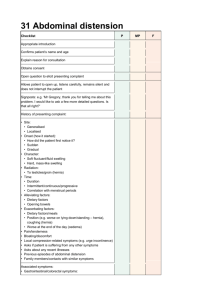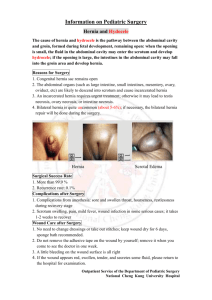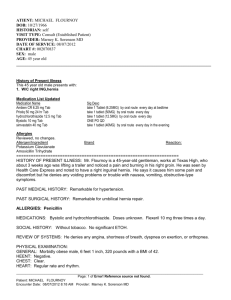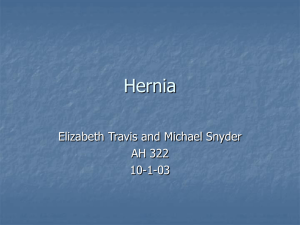Hernia
advertisement
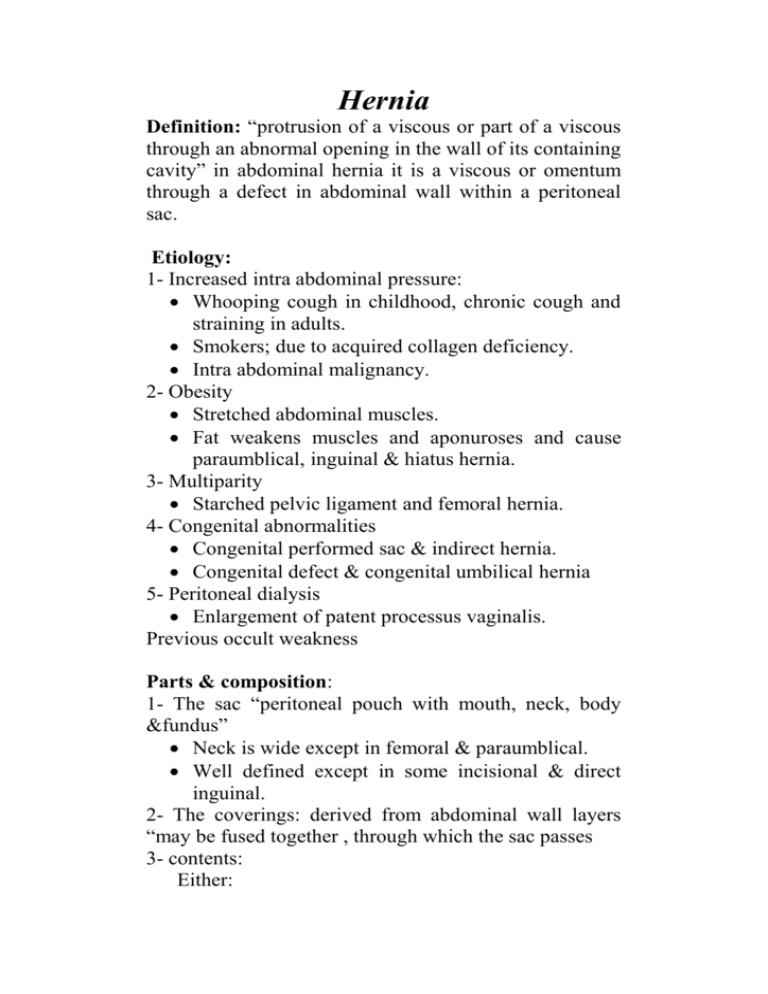
Hernia Definition: “protrusion of a viscous or part of a viscous through an abnormal opening in the wall of its containing cavity” in abdominal hernia it is a viscous or omentum through a defect in abdominal wall within a peritoneal sac. Etiology: 1- Increased intra abdominal pressure: Whooping cough in childhood, chronic cough and straining in adults. Smokers; due to acquired collagen deficiency. Intra abdominal malignancy. 2- Obesity Stretched abdominal muscles. Fat weakens muscles and aponuroses and cause paraumblical, inguinal & hiatus hernia. 3- Multiparity Starched pelvic ligament and femoral hernia. 4- Congenital abnormalities Congenital performed sac & indirect hernia. Congenital defect & congenital umbilical hernia 5- Peritoneal dialysis Enlargement of patent processus vaginalis. Previous occult weakness Parts & composition: 1- The sac “peritoneal pouch with mouth, neck, body &fundus” Neck is wide except in femoral & paraumblical. Well defined except in some incisional & direct inguinal. 2- The coverings: derived from abdominal wall layers “may be fused together , through which the sac passes 3- contents: Either: Omentocele (epiplocele) with doughy sensation. Intestine (enterocele) with gurgling sensation. Portion of bladder or adenexae . Fluid (hydrocele of hernial sac). Ovary or fallopian tube Types of hernia a) pathological types Reducible: (either spontaneous or induced) o Expancile impulse on cough. Irreducible: (either sole finding or with other complications o Either from adhesions or over crowding within the sac. Strangulated hernia o Definition “impedance of the blood supply pf the content” gangrene ensues after 5-6 hours. o clinical picture: 1. Colicky or may be stabling pain mainly at umbilicus. 2. Nausea and vomiting & may be constipation. 3. on examination: Bad general condition. Tense, tender, irreducible hernia. No expansile impulse on cough. obstructed hernia: Irreducible hernia containing intestine which is obstructed from within or without but no interference with blood supply. Presentation is intestinal obstruction inflamed hernia: o inflamed content (acute appendicitis or salpingitis) or external cause (e.g. truss or trophic ulcer in large hernias) treatment is treatment of the cause B) Anatomical types of Hernia 1. Inguinal hernia: It is a hernia which transverse the inguinal cana to appear from the external ring. Types 1. Congenital Usually appears in infancy and young age 2. indirect Inguinal hernia pass from the deep inguinal ring through canal to superficial inguinal ring. ( commonest type ntile umbilical hernia 3.direct Inguinal hernia pass back to the inguinal canal then protrude through the external ring. Clinical picture Incidence 70% of all hernias commonest in infants , children and young adults 30% bilateral , males 20 times common than females Symptoms and signs Pain and swelling. Intermittent expansile impulse with cough Treatment Operation ?? rule of truss 2. Umbilical hernia a. Congenital ( Exomphalos) Failure of return of mid gut to the abdomin b. Infantile It is due to weak umbilicus obstruction or strangulation is rare until 3 years Ttt is operation at age of 2 years c. paraumbilical It is perfusion of linea alba just above or may be just below umbilicus. Clinical picture Either round or oval shape. Women are five times affected more than men. Mainly in age of 35-50 Predisposing factors Obesity Rgging painepeated pregnancy Colic , constipation , dragging pain , skin laceration Treatment Operation 3. Incisional hernia (post operative hernia) Predisposing factors : a. preoperative cause b. operative causes c. post operative causes , mainly smoking , obesity , straining , cough , wound infection , distention Clinical picture The hernia appears within months , weeks or years after operation on a previous scar either through the whole scar or part of the scar Treatment Rule of abdominal belt ?? because it has a wide neck , mainly at upper abdominal incisional hernias


